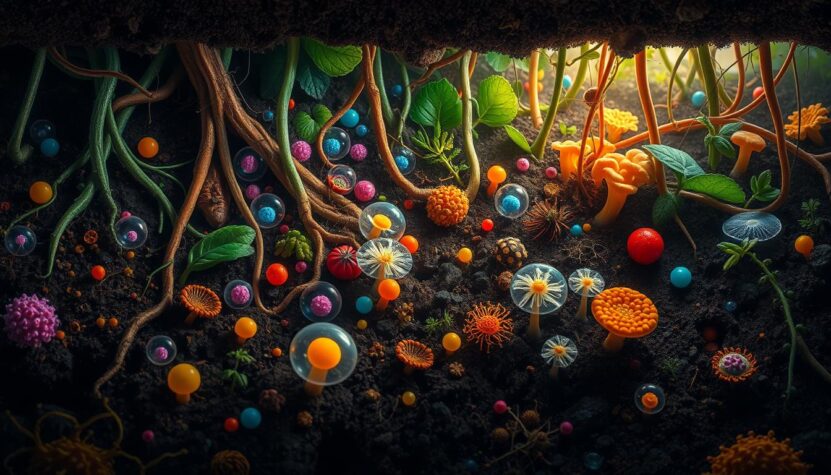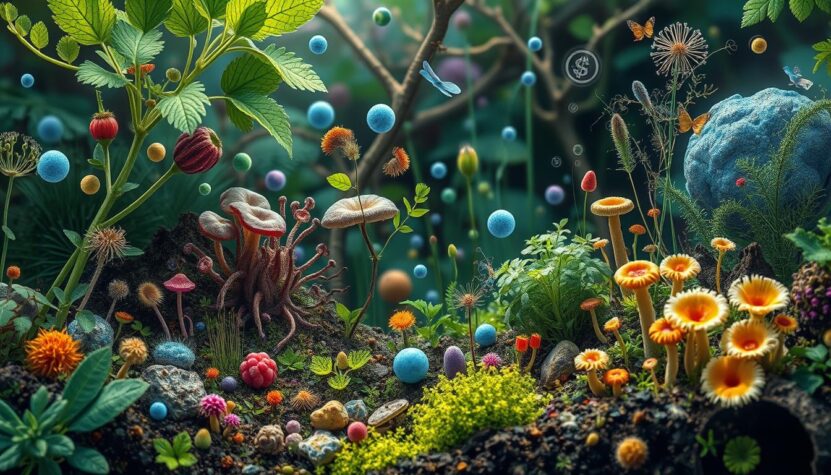Tiny organisms, often overlooked due to their minute size, play a monumental role in maintaining the health and balance of ecosystems. These microorganisms, both bacteria and fungi, are vital for numerous ecological processes. Every year, over 100 million tons of sugar and approximately 100-115 million tons of carbon are converted into biomass through photosynthesis, largely thanks to these organisms. They are the unsung heroes of nutrient cycling and decomposition, acting as the backbone of life on Earth.
As you explore the intricate web of life that sustains our planet, you’ll discover the profound ecological importance of microorganisms. They not only support biodiversity but also contribute to healthier air and soil, crucial factors for sustainable living. By understanding their role within ecosystems, you will gain insight into why preserving these tiny entities is paramount for our collective well-being and the future of our environment.
The Vital Role of Tiny Organisms in Ecosystems
Microorganisms serve as fundamental components of ecosystems, providing essential services that support life. Diverse groups of these tiny creatures, including bacteria, fungi, and protozoans, contribute significantly to the health and stability of ecosystems and biodiversity. Understanding their roles reveals the intricate connections that define the balance of life on our planet.
Microorganisms as the Backbone of Ecosystem Function
Bacteria link vital processes within ecosystems. They are responsible for producing approximately 50% of the total oxygen over Earth’s history. Bacteria also play a crucial role in the nitrogen cycle, contributing to 75% of nitrogen additions and 92% of removals in the atmosphere. Furthermore, these organisms generate about 88% of nitrous oxide (N2O) emissions, a greenhouse gas over 300 times more potent than CO2, showing how microorganisms influence climate variables.
The presence of microorganisms directly affects other organisms, establishing a foundation for higher trophic levels. In aquatic environments, a concentration of 10^6 cells/mL of water exemplifies their abundance. In soil, the figures climb to nearly 10^9 cells/mL, facilitating nutrient recycling and supporting plant growth.
Understanding Ecosystem Balance and Biodiversity
The intricate balance maintained by microorganisms is critical for promoting biodiversity. Their activities foster conditions conducive to various life forms by decomposing organic matter, recycling nutrients, and improving soil fertility. For instance, fungi uniquely contribute to ecosystem health by completely degrading lignin, a resilient component of plant structure, facilitating carbon cycling within terrestrial environments.
In many ecosystems, the loss of these vital organisms for ecosystem health can trigger a cascade of detrimental effects, threatening the entire ecological web. This interconnectedness highlights the necessity of preserving microbial biodiversity to ensure ecosystem sustainability and resilience against environmental changes.
Microbial Processes That Support Life
In the intricate web of life on Earth, microbial processes serve as essential components that support various ecosystem functions. Understanding these processes reveals how organisms maintain ecosystems and highlight the importance of microscopic life in nature.
Decomposition and Nutrient Cycling
Decomposition is a fundamental process in which bacteria and fungi break down organic materials, returning vital nutrients to the soil. This cycling of nutrients fosters plant growth and sustains various life forms. Microbes have a collective mass greater than all the animals on the planet, emphasizing their critical role in maintaining ecological balance. By recycling nutrients and enriching the soil, these microscopic organisms help sustain plant life, which in turn supports herbivores and the larger food web.
Photosynthesis: The Oxygen Producers
Photosynthetic bacteria contribute significantly to the oxygen we breathe, producing about 50% of the Earth’s oxygen supply. These microorganisms convert sunlight into chemical energy, showcasing the vital relationship between sunlight and ecosystem function. Without the contributions of these tiny organisms, life as you know it would be impossible. They play an indispensable role in the intricate processes that sustain life, demonstrating the significance of microscopic life in nature.
How Tiny Organisms Keep Ecosystems Running
Microbial diversity is essential for the functionality and resilience of ecosystems. Tiny organisms play a pivotal role in maintaining balance within the environment, directly impacting biodiversity and tiny organisms. Understanding these interactions helps highlight how organisms maintain ecosystems effectively.
The Importance of Microbial Diversity
A diverse microbial community contributes to various ecological functions. Microbes engage in nutrient cycling, breaking down organic materials from dead plants and animals. This process releases carbon back into the soil and air, enhancing soil fertility and promoting plant growth. For instance, nitrogen-fixing bacteria convert atmospheric nitrogen into ammonia, allowing plants to absorb this vital nutrient and flourish.
Microbial Interactions: Symbiosis and Competition
Microbes form intricate networks through symbiotic partnerships with plants and animals. In leguminous plants, nitrogen-fixing bacteria establish mutually beneficial relationships, providing essential nitrogen in exchange for organic sugars. Similarly, coral reefs rely on microscopic algae for energy through photosynthesis, showcasing a unique partnership that benefits both organisms.
Competition among microorganisms also plays an important role in maintaining ecosystem health. Different microbial species compete for resources, helping regulate populations and encouraging genetic diversity. Such interactions ensure that ecosystems can adapt to environmental changes and stressors while supporting robust biodiversity.
| Microbial Function | Examples | Benefits |
|---|---|---|
| Nutrient Cycling | Bacteria, Fungi | Enhances soil fertility, supports plant growth |
| Bioremediation | Microbes breaking down oil | Cleans up pollution, restores ecosystems |
| Symbiosis | Nitrogen-fixing bacteria with legumes | Provides nitrogen, enhances plant health |
| Wastewater Treatment | Microbes in treatment plants | Break down harmful substances, ensure clean water |
In summary, the diversity of microorganisms underpins the essential functions within ecosystems. Their interactions through symbiosis and competition not only sustain individual species but also contribute significantly to the health and stability of the environment. Understanding the complexities of these relationships emphasizes the critical role of microorganisms in maintaining biodiversity and the overall balance of ecosystems.
Microorganisms and Their Impact on Soil Health
The health of soil plays a crucial role in how ecosystems function, largely due to the activity of microorganisms. These tiny organisms, including bacteria and fungi, are vital to maintaining the ecological importance of microorganisms within soil environments. Without them, ecosystems would struggle to maintain balance. You can find them working in various capacities, from promoting soil fertility to establishing stable ecosystems. The multifaceted roles of these organisms highlight their inherent value in supporting healthy soils.
How Bacteria Improve Soil Fertility
Bacteria contribute significantly to soil health through various mechanisms. They are responsible for decomposing organic matter, which releases essential nutrients like nitrogen, phosphorus, and potassium back into the soil. This nutrient release is crucial for plant growth and sustains the overall ecosystem balance. Some bacteria, such as rhizobia, engage in symbiotic relationships with legume plants, converting atmospheric nitrogen into ammonia, making it readily available for plants. This enhances soil fertility and promotes robust agricultural systems.
Fungi and Their Role in Ecosystem Stability
Fungi also play an indispensable role in maintaining soil health and stability. Mycorrhizal fungi form extensive networks with plant roots, enhancing water and nutrient uptake, particularly during dry periods. This relationship not only benefits the plants but also contributes to the overall ecological importance of microorganisms by improving soil structure and resilience. Fungal networks can even suppress harmful pathogens, protecting plants from diseases. The presence of these microorganisms in the soil directly influences how organisms maintain ecosystems, highlighting their essential role in agricultural productivity and environmental health.

| Microorganism Type | Primary Function | Impact on Soil Health |
|---|---|---|
| Bacteria | Decomposition and Nutrient Cycling | Enhance soil fertility by releasing nutrients |
| Fungi | Mycorrhizal Associations | Improve water retention and suppress pathogens |
| Archaea | Organic Matter Decomposition | Contribute to nutrient cycling |
The Connection Between Microbes and Climate Resilience
Tiny organisms in ecosystems play a critical role in mitigating climate change. These microorganisms have the unique ability to break down greenhouse gases and influence carbon dynamics through various processes. Understanding their contributions helps highlight the importance of microbial communities in promoting ecosystem resilience.
Microorganisms Reducing Greenhouse Gas Emissions
Microbes significantly contribute to reducing greenhouse gas emissions, particularly methane. Methane is particularly concerning, as it is 25 times more effective at trapping heat than carbon dioxide. A large percentage of methane emissions originates from human activities, with livestock, especially cattle, being a major source. Rumen microbes residing in these animals are responsible for over 25% of global human methane emissions each year. Research initiatives aim to manage these microbial populations to decrease methane production. For instance, an inhibitor affecting a specific enzyme in cows has demonstrated the potential to lower enteric methane emissions by 30%.
The Role of Microbes in Carbon Sequestration
In addition to regulating methane levels, microorganisms facilitate carbon sequestration by decomposing organic materials and converting them into stable carbon forms in the soil. This process is essential for maintaining soil health, especially in the face of various environmental stresses such as temperature variations and moisture availability. The survival of these tiny organisms in ecosystems is influenced by factors such as relative humidity and temperature. As the Earth’s surface temperature continues to rise, understanding the impact of pollution on microbial communities becomes increasingly crucial, as it can substantially affect their functionality and resilience.
The Economic Value of Microorganisms in Ecosystems
The economic contributions of microorganisms are significant, influencing various sectors such as agriculture and aquaculture. Understanding the economic value of microorganisms allows us to better appreciate their role in ecosystems and their benefits to society.
Microbial Contributions to Agriculture
Beneficial microorganisms, including bacteria and fungi, play a crucial role in agriculture by enhancing soil fertility and promoting plant health. These microbes help decompose organic matter, recycle nutrients, and fix nitrogen, which are fundamental processes that sustain crop vitality. Utilizing these natural microbial processes can reduce dependency on chemical fertilizers, thereby promoting more sustainable agricultural practices. This shift not only supports higher crop yields but also contributes to long-term ecological balance.
Impact on Fisheries and Aquaculture
The impact on fisheries and aquaculture largely hinges on microorganisms. In aquatic environments, microbial populations maintain essential nutrient cycles and provide a foundation for food webs. Healthy microbial communities are vital for sustaining fish populations and ensuring the productivity of aquaculture systems. Such systems enhance food security and support livelihoods globally. The economic value of microorganisms in these settings cannot be overstated, as they underpin both the ecosystems’ structure and the economic activities dependent on them.

Threats to Microbial Biodiversity and Ecosystems
The delicate balance of microbial biodiversity faces numerous threats that can disrupt ecosystem functioning. Understanding these dangers proves essential not only for microbial health but also for the overall stability of ecosystems worldwide.
Impact of Pollution on Microbial Communities
Pollution exerts significant pressure on microbial communities, leading to the alteration of their composition and functionality. The presence of heavy metals, plastics, and other harmful substances can reduce microbial diversity, impacting their ability to perform essential ecosystem services such as nutrient cycling and decomposition. These changes can create imbalances that further exacerbate environmental degradation.
Climate Change and Its Effects on Microbial Function
Climate change introduces various stressors that can disrupt microbial activities. As temperatures rise and weather patterns shift, microbial communities may struggle to adapt, potentially leading to local and global extinctions. Altered biological event timing and distribution of various microorganisms further complicate these dynamics. The repercussions on ecosystem productivity, invasive species distribution, and species interactions can lead to unprecedented reconfigurations within ecosystems.
| Threat | Description | Impact on Microbial Biodiversity |
|---|---|---|
| Pollution | Introduction of harmful substances into the environment | Reduction in microbial diversity and functionality |
| Climate Change | Rising temperatures and changing weather patterns | Disruption of microbial activities and potential extinction |
| Habitat Loss | Destruction of natural environments | Altered microbial community structures |
Innovative Approaches to Protecting Microbial Ecosystems
Protecting microbial ecosystems requires a multifaceted approach that emphasizes community involvement in conservation and education. By actively engaging local communities, you can foster sustainable practices that enhance the management and restoration of ecosystems. This not only creates a sense of ownership and responsibility but also cultivates a deeper understanding of the vital roles that tiny organisms play in maintaining biodiversity.
Community Involvement and Education
Engaging communities in educational programs can significantly impact the effectiveness of conservation efforts. Through workshops, seminars, and hands-on activities, individuals learn about:
- The importance of microbes in nutrient cycling and ecosystem balance.
- How to participate in local conservation initiatives.
- The role of individuals in protecting microbial ecosystems.
Such educational efforts lead to greater awareness and motivation to participate in safeguarding these essential organisms. Emphasizing the impact of community involvement in conservation not only boosts morale but also fosters long-term dedication to preserving microbial habitats.
Restoration Projects and Their Success Stories
Successful restoration projects highlight the direct contributions of microbial ecosystems to revitalizing degraded environments. These initiatives often showcase how specific microbes contribute to soil health, water quality, and overall biodiversity. Examples include:
“Restoration of streams surrounded by silvopasture demonstrated bacterial diversity levels akin to those of forested streams, underscoring the importance of targeted land management in enhancing microbial communities.”
Moreover, the recovery of bacterial communities in reforested areas indicates how natural processes can restore balance. Protecting streams with forest corridors and implementing fencing in agricultural settings significantly improves ecosystem services, demonstrating the need for community participation in such efforts.
Conclusion
The health of our planet profoundly depends on the intricate web formed by tiny organisms in ecosystems. Their importance of microorganisms in ecosystems extends beyond mere survival; they are pivotal for essential processes such as nutrient cycling and oxygen production. As you reflect on the interconnectedness of life, consider that these microorganisms are the unsung heroes working diligently beneath our feet and in our oceans, sustaining the very foundation of ecosystems.
However, the future of microbial contributions is threatened by numerous factors, including pollution and climate change. Alarmingly, over one million species teeter on the brink of extinction, which poses significant risks not only to biodiversity but also to human health, as evidenced by the increasing spread of zoonotic diseases. With seventy percent of emerging viral diseases originating from animals, the urgency to protect microbial ecosystems has never been clearer.
Taking proactive measures to save these vital organisms is essential for ensuring a sustainable future. Protecting biodiversity is not just an environmental issue; it has critical implications for food security and the economy. With proper conservation strategies, we can harness the benefits of healthy ecosystems, underscoring the necessity of preserving the delicate balance of life that microorganisms maintain. The path forward requires collective action and a commitment to understanding the pivotal role microorganisms play in our world.
